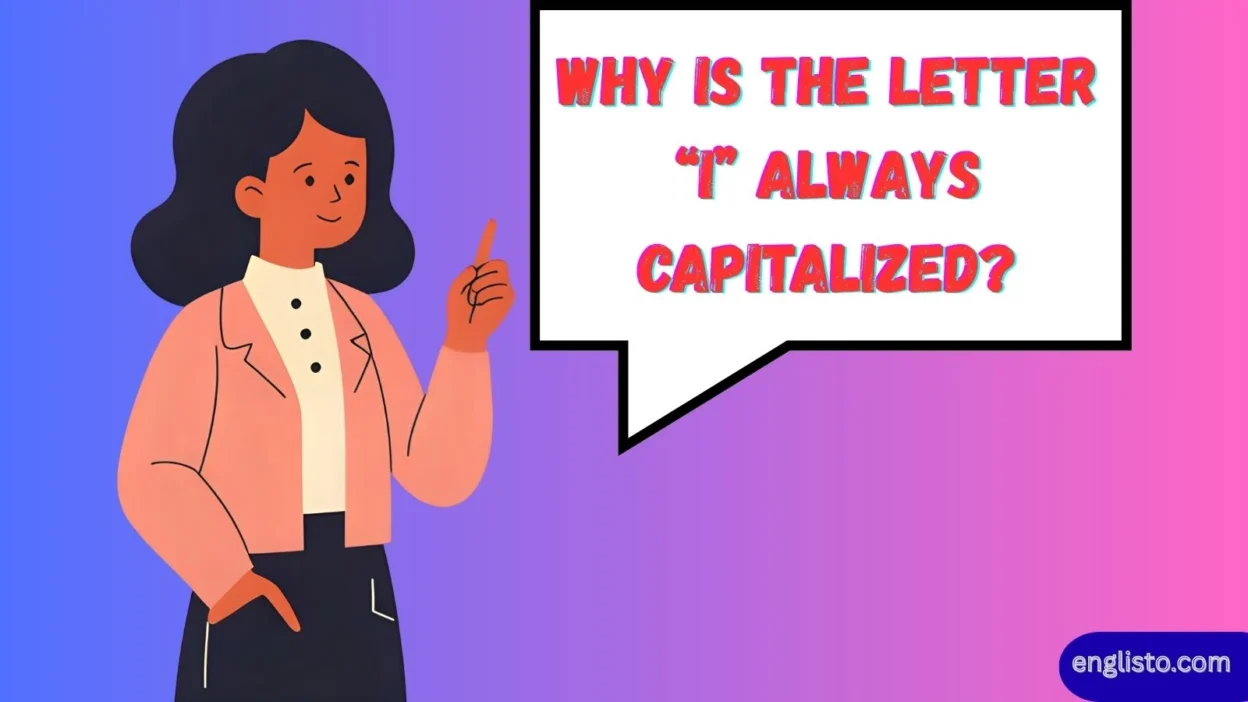Language is full of quirks, but one of the most unusual features in English is the capitalization of the pronoun “I.” Unlike he, she, they, we, or you, the single-letter “I” is always written in uppercase, even in casual writing like emails, text messages, or social media posts. Why does this happen? Is it just a grammar rule, or is there a deeper cultural, historical, and linguistic explanation? Why is the Letter “I” Always Capitalized?
This article unpacks the fascinating history, typographic reasons, psychological implications, and cultural traditions behind the capital “I.” From medieval manuscripts to modern texting, we’ll explore why the lone letter “I” refuses to shrink into lowercase—and why this tiny character carries such a massive symbolic burden.
The Uniqueness of the Pronoun “I” in English
English is almost alone in this rule. In French (“je”), Spanish (“yo”), German (“ich”), and Italian (“io”), the equivalent pronouns remain lowercase. Yet English insists on elevating “I” with uppercase treatment.
Why is this?
- Visual clarity: A lowercase “i” standing alone looks fragile, thin, and hard to read.
- Identity: The uppercase “I” symbolizes selfhood, importance, and presence.
- Typographic evolution: In handwritten manuscripts and early printing, “i” was too small to stand out, leading scribes to enlarge it.
| Language | First-person Pronoun | Capitalized? | Notes |
| English | I | Yes | Always capitalized in all contexts |
| French | je | No | Lowercase, even at sentence start |
| German | ich | No | Capitalizes nouns, not pronouns |
| Spanish | yo | No | Always lowercase |
| Italian | io | No | Lowercase unless at sentence start |
This table shows how English breaks away from the norm, making the uppercase “I” a distinct identity marker.
Read More: Comma: When to Use It Before “Which” and “Who”
Historical Roots: From Old English to Middle English
The story begins in Old English (around the 11th century). The first-person singular pronoun was written as “ic” (related to German ich). Over time, in Middle English (13th–14th centuries), this shortened to “i.”
But here’s the problem:
- Medieval manuscripts used Gothic script with many minims (short vertical strokes). Letters like m, n, u, i looked nearly identical.
- A lone “i” could easily disappear on the page, making sentences unclear and confusing.
Scribes began stretching the single “i” upward, eventually transforming it into a majuscule (uppercase) I. By the late 1300s, this became common practice.
Example: Chaucer’s Manuscripts
In The Canterbury Tales, early handwritten copies already display the capital “I,” reinforcing that this was not just aesthetic but practical for readability.
Typographic and Printing Press Influence
With the invention of Gutenberg’s printing press in the 15th century, consistency became essential. Printers favored clear, legible characters that wouldn’t cause misreading.
- The lowercase “i” was too small when standing alone.
- The uppercase “I” created balance and symmetry in sentences.
For instance:
- “i am going to the store” → visually awkward
- “I am going to the store” → clear and assertive
Typography experts like Charles Bigelow (designer of Lucida and Wingdings fonts) argue that “I” carries a graphic authority, making it stronger than its lowercase form.
Psychological and Cultural Symbolism
Capitalizing “I” is not only about clarity—it’s about identity and importance.
- Individualism in Western culture: English-speaking societies emphasize the self as central. The capital “I” reflects this mindset.
- Symbol of autonomy: Unlike “me” or “us,” “I” stands for one’s own voice, choices, and independence.
- Prestige and confidence: Using a lowercase “i” can appear careless, childlike, or even rebellious in formal contexts.
“The capital ‘I’ is a declaration of selfhood. It demands attention, recognition, and respect.”
Comparisons With Other Languages
Other languages don’t need to capitalize their first-person pronoun because context, grammar, and conjugation already make the subject clear.
For example:
- Spanish: “Yo hablo inglés.” (I speak English.)
- French: “Je suis fatigué.” (I am tired.)
- German: “Ich gehe nach Hause.” (I’m going home.)
In English, verbs don’t always mark the subject clearly, so the pronoun itself becomes more important. The uppercase “I” provides emphasis and clarity.
Exceptions in Modern Usage
Interestingly, not everyone follows the rule. In casual emails, instant messages, or text conversations, people sometimes type “i” instead of “I.”
Examples:
- “i’ll be there in 10 minutes.”
- “can i call you later?”
This is usually due to speed typing, laziness, or stylistic choice. Some writers, like the poet e.e. cummings, even embraced lowercase letters as an artistic rebellion against conventions.
However, in formal writing—academic papers, professional emails, journalism—the capital “I” remains non-negotiable.
Grammar Rules and Usage Tips
The capitalization of “I” follows the same principles as capitalizing proper nouns or the first word in a sentence.
Here are quick grammar tips and tricks:
- Always capitalize “I” when it stands alone.
- Capitalize “I” in contractions: I’m, I’ll, I’d, I’ve.
- Do not lowercase “I,” even in poetry, creative writing, or text messages (unless stylistically intentional).
| Correct Usage | Incorrect Usage |
| I’m going to the library. | i’m going to the library. |
| Brian and I went to the store. | Brian and i went to the store. |
| She said that I could join. | She said that i could join. |
Sociolinguistic Implications
The capital “I” also reflects social hierarchies and communication norms.
- In Rastafarian Jamaican Creole, writers sometimes use “I and I” to represent unity with God and community, elevating the individual beyond the ego.
- In internet culture, lowercase “i” sometimes signals humility, informality, or rejection of traditional grammar.
- In academic and journalistic writing, capital “I” maintains authority and credibility.
Thus, the letter’s capitalization isn’t just grammatical—it’s cultural and symbolic.
Typographic Evolution and Fonts
The survival of the uppercase “I” also owes much to typographic design.
- In sans serif fonts, lowercase “i” looks weak alone.
- In serif fonts, the capital “I” has strong vertical strokes, standing tall and dignified.
- With digital writing (emails, websites, mobile texting), clarity is even more essential, making lowercase “i” appear sloppy or confusing.
Philosophical and Literary Perspectives
The capital “I” has often been linked to individualism, freedom, and self-expression.
- Ralph Waldo Emerson saw “I” as the essence of self-reliance.
- Robert Greene, in The Laws of Human Nature, connects selfhood to empowerment and independence.
- Writers like Geoffrey Chaucer and William Shakespeare reinforced the tradition of the capital “I,” embedding it deeply into English literary culture.
FAQs About Why “I” Is Capitalized
Q1: Is English the only language that capitalizes “I”?
Yes, English is unique in this rule. Most other languages keep their first-person pronoun lowercase.
Q2: When did the capitalization of “I” begin?
It began in Middle English around the 13th–14th centuries, mainly for clarity in manuscripts.
Q3: Is it wrong to write “i” in texting?
Not technically wrong, but it looks informal, careless, or stylistically intentional.
Q4: Why don’t we capitalize “me” or “us”?
Because they are longer words that don’t suffer from visual ambiguity like a single “i.”
Q5: Does capitalization of “I” reflect culture?
Yes. It mirrors the English-speaking world’s focus on individualism, clarity, and identity.
Conclusion
The capitalization of the pronoun “I” may seem like a small detail, but it’s a window into history, culture, and psychology. From medieval scribes struggling with Gothic letters, to the printing press, to modern digital screens, the uppercase “I” has survived because it is clear, authoritative, and symbolic.
It reminds us that in English, the self is not small. It stands tall, proud, and capitalized—every time.



